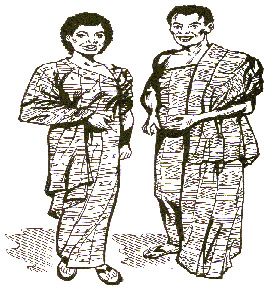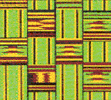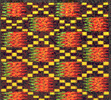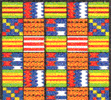"KENTE" is a brilliantly colourful fabric, entirely hand-woven by Ghanaian weavers. The brilliant colours and intricate designs associated with Kente have definitely made this fabric the best known of all Ghanaian, and perhaps even all West African textiles. Every design has a story with a proverbial meaning, giving each cloth its own distinction.
Uses Of Kente
Kente cloth is usually worn for ceremonies, festivals, and other sacred occasions. It is also given as a gift for weddings, child naming ceremonies, graduations, and other special events.
Women wear the cloth in 2 pieces - 1 piece about 2 yards long and 45 inches wide wrapped round the waist to form a floor-length skirt worn over a blouse specially sewn in plain material. The other Kente piece was either hung loosely over the arm or used as a shawl or stole.
Men wear the cloth in much the same way as the 'Toga' was worn by the ancient Greeks, and it would seem that these ancient people must have been in contact centuries ago.
 Traditional Way Of Wearing Kente Cloth By Both Genders |
Kente Patterns
The patterns of the cloth have
evolved with the rigid standards of society itself, so one can
easily say that if Kente were taken away from Ghana, it would
be like taking the 'Kimono' away from Japan. Ghana and the
Kente are culturally inseparable.
The patterns are so
intricate that the artist, amid a welter of balls of cotton
thread of every colour, must sometimes snip off tiny bits to
be applied over a width of about 1 centimeter, or even one
milimetre, while carefully counting the woof
threads.
Kente Samples/Designs
 |
Obi Nkye Obi Kwan Mu
Si (o-Bee n-che o-Bee k-wahn moo
see) The name of this pattern translates into "sooner or later one could stray into another person's path." The meaning of this saying is that nobody is perfect and everybody makes mistakes. If someone happens to get in your way or does something to offend you, it is important to be understanding and to forgive that person. |
 |
Asonawo Ahahamono Emaa Da (ahs-OHN-awoh ah-ahamo-no e-MAH da) This cloth represents "the green snake of the Asona," one of the seven families.The Asante social system has seven main families. Each family has its own responsibilities and rights. |
 |
Fathia Fata Nkrumah (Fa-THEA
fah-TA n-KROH-mah) The translation for the name of this pattern is "Fathia is a befitting wife for Nkrumah." Fathia was a charming Egyptian woman who married Nkrumah, the first president of the Republic of Ghana. Their marriage was considered special because it represented the unity of African peoples on the continent. |
 |
Abusua Ye Dom (AH-boo-soo-ah
yeh dohm) The name for this pattern means, "the extended family is a force." This cloth celebrates the extended family and its important role in maintaining the well being of its members. |
The History Of Ghanaian Kente
The history of
Kente weaving extends back more than 400 years. The word
"Kente" comes from the word "kenten", which means basket. The
very first Kente weavers used raffia, or palm leaf fibers, and
wove them into a cloth that looked like a basket.
One
story about Kente says that two friends learned to weave by
observing a spider weave its web. They wove in imitation of
the spider, using raffia fibers to create a strip of fabric.
Their leaders were so impressed with this new cloth that it
became the royal cloth and was saved for special occasions.
There are more than 300 different patters of Kente cloth. Each
pattern has a name and its own meaning. The meanings come from
past events, religious beliefs, political ideas, and social
customs.
Kente Colours And Their
Meanings
| Yellow | represents the yolk of the egg as well as certain fruits and vegetables. The colour is a symbol for things that are holy and precious. |
| Pink | is used to symbolize gentle qualities such as calmness, sweetness, and tenderness. |
| Red | stands for blood and for strong political and spiritual feelings. |
| Maroon | is associated with the colour of Earth, the mother. It represents healing and protection from evil. |
| Blue | stands for the sky and is used to symbolize holiness, peace, harmony, good fortune, and love. |
| Green | is associated with plants and stand for growth and good health. |
| Gold | like the metal gold, is a symbol of royalty, wealth, and spiritual purity. |
| White | represents the white of an egg as well as the white clay that is used in certain rituals. It stands for purity and healing. |
| Black | stands for aging because in nature things get darker as they get older. Black also stands for strong spiritual energy, and the spirits of the ancestors. |
| Grey | represents ashes, which are used for spiritual cleansing. |
| Silver | stands for the moon and represents serenity, purity and joy. |
| Purple | like maroon, is associated with Earth and with healing. |